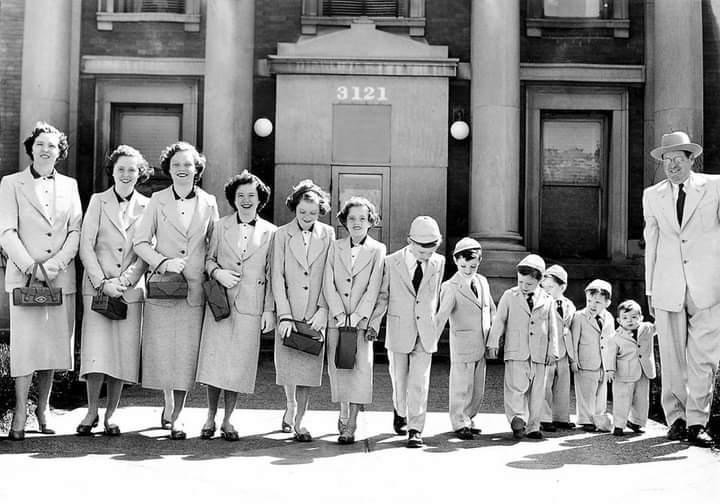In the spring of 1954, a remarkable photograph captured a moment in time for a family of thirteen, dressed in their Sunday best to commemorate Palm Sunday. The image presents a husband and wife alongside their eleven children, each donning matching outfits, embodying the fashion and family values of the era. The photograph is more than a family portrait; it’s a snapshot of the mid-20th-century American life, encapsulating a sense of unity, tradition, and celebration.

The Significance of Palm Sunday Attire
Palm Sunday, a Christian feast that falls on the Sunday before Easter, commemorates Jesus’ triumphant entry into Jerusalem, an event marked by the followers who greeted Him with palm branches. In 1954, this religious observance was also an occasion for families to come together and celebrate in their Sunday finery, a tradition that this family embraced wholeheartedly. Their coordinated outfits speak to the customs of the time, where dressing up for church was a way to show respect for the sacredness of the day.
Family Values in the 1950s
The 1950s in America were a time when family values were emphasized in popular culture and daily life. The couple, standing proudly with their children, reflects the societal norms of the time, which celebrated large families and the roles of parents in providing guidance and stability. This photograph, with the parents bookending their line of offspring, radiates the pride and joy of family life, an ideal deeply ingrained in the ethos of the time.
A Glimpse into 1950s Fashion
The fashion depicted in the photograph is quintessentially 1950s. The women’s and girls’ tailored suits, modest hemlines, and conservative hats, along with the men’s and boys’ crisp suits and smart fedoras, illustrate the era’s style. The attention to detail, with matching accessories and polished shoes, shows a dedication to appearance that was a hallmark of the decade’s fashion sensibilities.
This Palm Sunday photograph from 1954 offers more than a glimpse into the personal history of a particular family; it opens a window into the social history of the time. It highlights the religious traditions, family dynamics, and fashion trends of the 1950s, serving as a charming and poignant reminder of a bygone era.

Reflecting on a Bygone Era: The 1950s in America
The decade of the 1950s has left an enduring imprint on American society, weaving a narrative of post-war affluence, burgeoning suburban communities, and a reinvigorated focus on the nuclear family. The poised family of thirteen, captured in the photograph from Palm Sunday, 1954, serves as a tableau of the period’s ethos, where prosperity was celebrated in the sanctity of tradition and unity.
This era also saw the emergence and recognition of influential military leaders whose careers and decisions helped shape the nation’s future. Among these figures was a distinguished general whose strategic acumen and leadership during World War II earned him an esteemed place in military history. His story is emblematic of the 1950s—a time when the country, though facing the complexities of a Cold War world, held fast to values of discipline, honor, and collective identity.
For a comprehensive understanding of this iconic military figure and his contributions to America’s military legacy, a journey through The Soldier’s General: Omar Bradley’s Impactful Military Legacy offers a window into the life of a man who not only shaped military strategies but also exemplified the leadership ideals of his time.
The photograph, with its silent testimony to family and societal values, and the general’s legacy, with its resonance of leadership and duty, together reflect the multifaceted nature of the 1950s. They underscore a time of simplicity and complexity, where the collective consciousness was as much about looking forward as it was about holding on to the cherished ideals of the past.
As an Amazon Associate we earn from qualifying purchases through some links in our articles.




